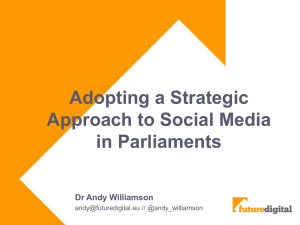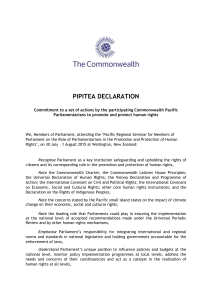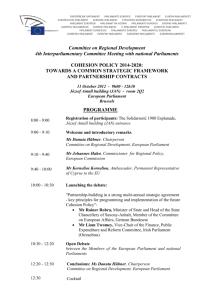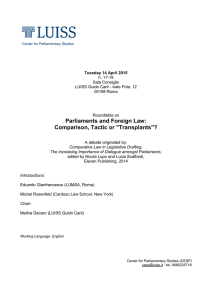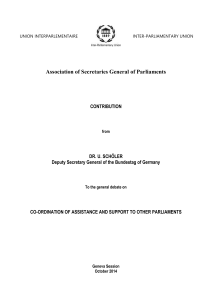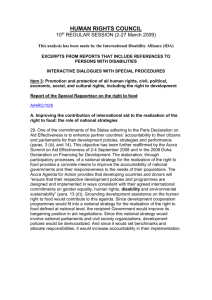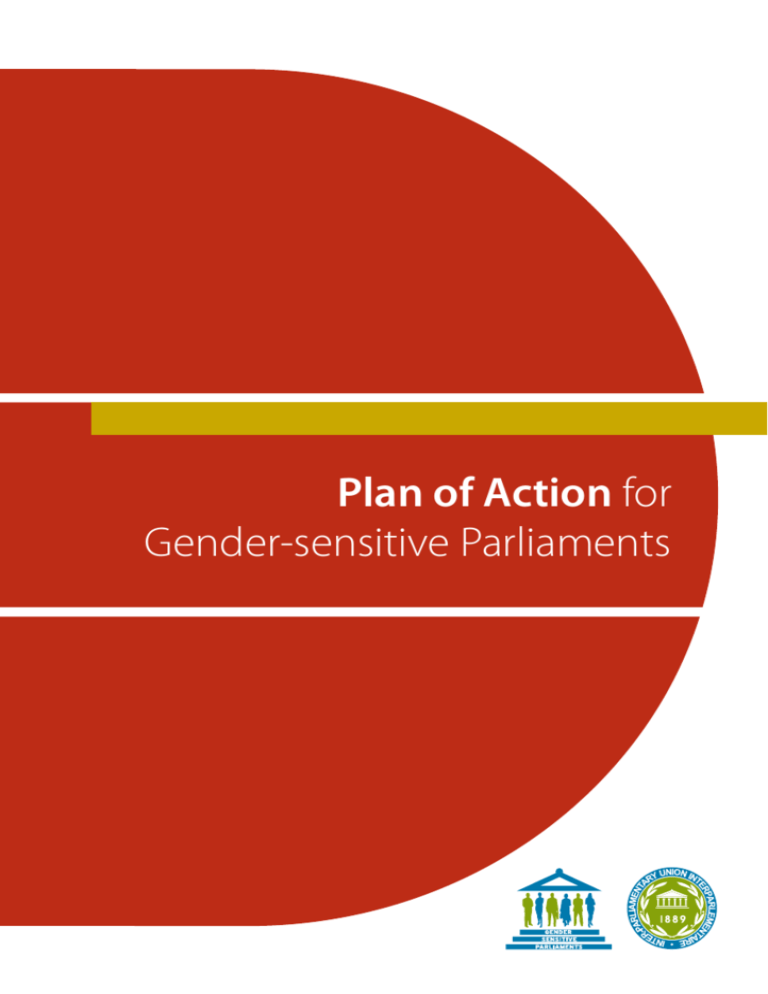
Plan of Action for
Gender-sensitive Parliaments
Copyright © INTER-PARLIAMENTARY UNION 2012
All rights reserved. No part of this publication
may be reproduced, stored in a retrieval system,
or transmitted in any form or by any means,
electronic, mechanical, photocopying, recording, or
otherwise, without the prior permission of the InterParliamentary Union.
This publication is distributed on condition that it be
neither lent nor otherwise distributed, including by
commercial means, without the prior permission of
the publishers, in any form other than the original
and on condition that the next publisher meets the
same requirements.
Applications for the right to reproduce or translate
this work or parts thereof are welcomed and should
be sent to the Inter-Parliamentary Union. Member
Parliaments and their parliamentary institutions may
reproduce or translate this work without permission,
but are requested to inform the Inter-Parliamentary
Union.
Photo credits: all pictures ©IPU, except the one on
page 18 © Tanzanian Parliament
ISBN: 978-92-9142-551-8
Plan of Action for
Gender-sensitive Parliaments
Contents
Part 1: Preamble and Objectives 7
Preamble 8
Objectives 10
Part 2: Key Action Areas of the Plan 13
Action area 1: Increase the number of women in parliament and
achieve equality in participation 14
Action area 2: Strengthen gender equality legislation and policy 16
Action area 3: Mainstream gender equality throughout all parliamentary work 20
Action area 4: Institute or improve gender-sensitive infrastructure and
parliamentary culture 24
Action area 5: Ensure that responsibility for gender equality is shared by all
parliamentarians – men and women 26
Action area 6: Encourage political parties to be champions of gender equality 28
Action area 7: Enhance the gender sensitivity of, and gender equality among,
parliamentary staff 30
Part 3: Implementation of this Plan of Action Initiate and implement gender-sensitive reform in parliament
34
The role of the IPU in supporting gender-sensitive parliaments 36
Annex: Basic Definitions 4
33
38
Plan of Action for Gender-sensitive Parliaments
Plan of Action for Gender-sensitive Parliaments
Adopted unanimously by the 127th IPU Assembly
(Quebec City, 26 October 2012)
The 127th IPU Assembly,
Having before it the Plan of Action for Gender-sensitive Parliaments,
Considering that the document was drawn up following an extensive process of
consultation with IPU Members,
Mindful that the document resulting from this process proposes concrete
solutions to situations common to all countries while offering a wide range of
options responding to individual situations – national and regional – and that it
represents a common basis for the advancement of gender-sensitive parliaments
in all countries,
1. Decides to adopt the Plan of Action for Gender-sensitive Parliaments;
2. Strongly encourages Members to bring this Plan of Action to the attention of
their parliaments and governments, disseminate it as widely as possible and
implement it at the national level;
3. Requests the IPU Secretary General to ensure that this document is
circulated as widely as possible at the international level and to promote its
implementation at the national level.
Inter-Parliamentary Union
5
6
Plan of action for gender-sensitive Parliaments
Part
Key Action Areas of the Plan
2
Plan of Action for
Gender-sensitive Parliaments
Part
Preamble and Objectives
Inter-parliamentary Union
1
7
Preamble
Democracy requires constant evaluation and reassessment. In the 20th
century, one of the greatest changes to democracy around the world was the
inclusion of increasing numbers of women, both as voters and as members of
parliament.
In parallel, gender equality and women’s empowerment have become
an integral part of the international political and development agenda,
recognized as being at the heart of progress towards, and achievement
of, the Millennium Development Goals (MDGs). Gender equality means
that women and men enjoy full and equal rights, responsibilities and
opportunities. Gender equality and women’s empowerment are human
rights, requiring political and legal expression. Countries must promote,
respect and protect women’s human rights, including gender equality.
Progress towards these goals requires direct action. While specific actions
may need to take into account the individual cultural, social and religious
context of parliaments around the world, progress essentially requires a
widespread change in attitudes and perceptions.
Parliaments are well placed to champion the goal of gender equality.
Parliaments aim to reflect society, and so they must reflect the changing
dynamics of their electorates.
A gender-sensitive parliament is a parliament that responds to the needs
and interests of both men and women in its composition, structures,
operations, methods and work. Gender‑sensitive parliaments remove
the barriers to women’s full participation and offer a positive example or
model to society at large. They ensure that their operations and resources
are used effectively towards promoting gender equality.
A gender-sensitive parliament is one in which there are no barriers –
substantive, structural or cultural – to women’s full participation and to
equality between its men and women members and staff. It is not only a
place where women can work, but also one where women want to work
8
Plan of Action for Gender-sensitive Parliaments
Part
Preamble and Objectives
1
and contribute. A gender-sensitive parliament sets a positive example by
promoting gender equality and women’s empowerment among society
both nationally and internationally.
A gender-sensitive parliament is therefore a modern parliament; one
that addresses and reflects the equality demands of a modern society.
Ultimately, it is a parliament that is more efficient, effective and legitimate.
The IPU Gender Partnership Group presents the Plan of Action for Gender-sensitive
Parliaments for adoption by the 127th Assembly (Quebec City, 26 October 2012).
Inter-Parliamentary Union
9
Objectives
This Plan of Action is designed to support parliaments in their efforts to
become more gender-sensitive. It presents a broad range of strategies in seven
action areas that can be implemented by all parliaments, irrespective of the
number of women members.
Parliaments are called upon to take ownership of this Plan of Action and to
implement any or all of the Plan’s strategies at the national level by setting
concrete objectives, actions and deadlines suited to their national context.
They are also called upon to regularly monitor and evaluate their progress
towards the goal of gender sensitivity.
A gender-sensitive parliament responds to the needs and interests of both
men and women in its structures, operations, methods and work.
The Plan of Action is adopted by the 127th IPU Assembly.
10
Plan of Action for Gender-sensitive Parliaments
Part
Preamble and Objectives
1
A gender-sensitive parliament is one that:
1. Promotes and achieves equality in numbers of women and men
across all of its bodies and internal structures.
2. Develops a gender equality policy framework suited to its own
national parliamentary context.
3. Mainstreams gender equality throughout all of its work.
4. Fosters an internal culture that respects women’s rights,
promotes gender equality and responds to the needs and
realities of MPs – men and women – to balance work and family
responsibilities.
5. Acknowledges and builds on the contribution made by its men
members who pursue and advocate for gender equality.
6. Encourages political parties to take a proactive role in the
promotion and achievement of gender equality.
7. Equips its parliamentary staff with the capacity and resources to
promote gender equality, actively encourages the recruitment
and retention of women to senior positions, and ensures that
gender equality is mainstreamed throughout the work of the
parliamentary administration.
Inter-Parliamentary Union
11
12
Plan of action for gender-sensitive Parliaments
Part
Key Action Areas of the Plan
2
Plan of Action for
Gender-sensitive Parliaments
Part
Key Action Areas of the Plan
Inter-parliamentary Union
2
13
Action area 1
Increase the number of women in parliament and
achieve equality in participation
Equality of participation can be both a catalyst for implementing gendersensitive changes and an important outcome of successful gender-sensitive
changes.
Access to parliament
While the representation of women in parliaments has increased slowly
since the mid-twentieth century, it still does not match women’s broader
representation in society.
Increasing access to parliament through gender-sensitive changes will
help increase the number of women parliamentarians, which can in turn
prompt the further implementation of the principles of gender sensitivity.
To redress this imbalance, parliaments should implement one or more of
the following measures:
}} In line with their national context, adopt special measures to ensure
that higher numbers of women are selected by parties to run in
“winnable” seats, and propose amendments to electoral laws and
national constitutions that provide for reserved seats.
}} Condemn acts of violence against women candidates and
parliamentarians and adopt legal and practical measures to prevent
and punish such acts.
}} Conduct awareness-raising campaigns on the importance of women’s
representation in parliament.
}} Support mentorship programmes and promote women
parliamentarians as role models through parliament’s communications
tools and in the media.
14
Plan of Action for Gender-sensitive Parliaments
Part
Key Action Areas of the Plan
2
}} Facilitate the sharing of experiences and best practices among
parliamentarians through study tours to other parliaments in the
region and internationally.
Achieving equality in positions and roles
While the number of women in parliament is important, it is equally
important to have women in positions of parliamentary leadership.
The principles of gender-sensitive parliaments can be advanced if women
occupy leadership positions as parliamentarians and as key members
of parliamentary staff, as they are then in a position to influence policy
directions, change parliamentary procedure and practices, serve as role
models to other women and provide a different perspective in debates.
To improve the leadership status of women and achieve greater gender
equality in leadership positions, parliaments should implement one or
more of the following measures:
}} Adopt affirmative action measures and amend the internal rules so
as to give preference to women over men for parliamentary positions
(including committee chairs and leadership positions in the Bureau or
Board) in cases where qualifications are equal or commensurate with
their representation in the parliament.
}} Rotate positions of parliamentary leadership between men and women
over a period of time.
}} Introduce dual leadership for parliamentary structures, where possible,
through the appointment of a man and a woman.
}} Encourage the proportional and equitable distribution of women
parliamentarians across all committees, not just those relating to
women, children, gender, families, health and education.
}} Encourage persons in leadership positions to broaden the criteria used
to evaluate the relevance of women’s and men’s experience before
entering politics.
Inter-Parliamentary Union
15
Action area 2:
Strengthen gender equality legislation and policy
Parliaments can become more gender-sensitive by implementing legislation
and policies that support the principles of gender equality. The introduction
of gender equality and gender mainstreaming legislation can be an effective
catalyst for social and cultural change in attitudes towards gender equality.
Parliaments can also serve as a model for society by championing gender
equality through the implementation of gender-sensitive strategic policies,
action plans and operational and supporting policies.
National legislation
With the goal of promoting change in social and cultural attitudes towards
gender equality, parliaments should:
}} Enact laws that promote and protect gender equality; where gender
equality laws were enacted but have become outdated or were enacted
more than 10 years ago, parliaments should review such legislation
to include gender mainstreaming frameworks and mechanisms for
monitoring and enforcing implementation.
With the aim of guaranteeing a legislative mandate for gender
mainstreaming, parliaments should:
}} Consider introducing a law and/or mechanisms that require all
government policy and legislation to be reviewed and assessed for
their gender impact and compliance with the State’s obligations under
relevant international conventions, including the Convention on the
Elimination of All Forms of Discrimination against Women (CEDAW), the
Universal Declaration of Human Rights, the International Covenant on
Civil and Political Rights and the International Covenant on Economic
and Social Rights.
16
Plan of Action for Gender-sensitive Parliaments
Part
Key Action Areas of the Plan
2
Working Group on “Mainstreaming gender in all of parliament’s work”, Special Session on
Gender-sensitive Parliaments (Quebec City, 25 October 2012).
Parliament’s strategic policies and action plans
In order to serve as leaders and role models for championing gender
equality in society, parliaments should:
}} Develop a gender equality policy that sets out:
`` the rationale and strategic direction for implementing measures
contained in this Plan of Action,
`` concrete actions the parliament will take to address gender equality
within a specific timeframe, and
`` indicators to measure progress that are monitored regularly through
an appropriate parliamentary oversight mechanism.
Inter-Parliamentary Union
17
Opening debate with a woman and a man Speakers of parliament on “Transforming
parliaments for gender equality”, Special Session on Gender-Sensitive Parliaments (Quebec
City, 23 October 2012).
18
Plan of Action for Gender-sensitive Parliaments
Part
Key Action Areas of the Plan
2
}} Ensure that the parliament’s budget is gender-sensitive and that
accountability measures are in place to monitor progress.
Operational and supporting policies of the parliament
}} Develop media and communications policies
To ensure that the importance of promoting gender equality is well
understood and given the utmost visibility, parliament should:
`` develop a gender communications strategy that identifies target
audiences, key messages, methods and timeframes.
`` showcase and publicize their gender equality activities and outcomes
in the media, or through the parliament’s own communication
channels, including its website.
}} Develop anti-harassment and anti-discrimination policies
To ensure that all parliamentarians and parliamentary staff work in an
environment free from all forms of discrimination and harassment,
including sexual harassment, parliament should:
`` introduce a code of conduct that requires all parliamentarians to be
respectful and courteous and penalizes any language and behaviour
that is considered sexist.
`` develop and implement anti-discrimination and anti-harassment
policies in line with national legislation applicable to all
parliamentarians and parliamentary staff including the establishment
of an independent body to which complaints can be submitted and
addressed.
`` ensure that the language used in all official documents, including
standing orders, is gender-sensitive (e.g. does not refer to members
using the masculine pronoun “he” and uses Chairperson or Chair
rather than Chairman).
Inter-Parliamentary Union
19
Action area 3
Mainstream gender equality throughout all
parliamentary work
Gender inequality can be tackled effectively only if policies in all areas
are designed in such a way as to address the specific concerns, needs and
constraints of both women and men while building on their respective
capacities and contributions.
The mainstreaming of gender considerations in a parliament’s work is an
effective gender-sensitive change as gender mainstreaming is a process that
recognizes the economic, social, political and legal differences that exist
between women and men.
Committing to gender mainstreaming
Parliaments should demonstrate their commitment to gender
mainstreaming by showcasing and creating opportunities to incorporate a
gender dimension in all areas of their work. In this respect, they should:
}} Foster debates on legislation and budgets, including the implications
of such bills and expenditure allocations for women and men, girls
and boys (e.g. allocate time or hold a special session to debate the
allocations and expenditure for gender equality in the budget).
}} Develop clear gender-based legislative assessment guidelines or
toolkits (e.g. a gender-based checklist for all pieces of legislation,
including the budget).
}} Allocate time in the order of business for special debates on gender
equality or gender-specific questioning of ministers, in which both men
and women are encouraged to participate.
20
Plan of Action for Gender-sensitive Parliaments
Part
Key Action Areas of the Plan
2
}} Ensure that committees investigating gender equality concerns have
sufficient time and resources (including staff with gender expertise)
to fulfil their mandate, an opportunity to report back to the plenary
on their work and recommendations as well as the same powers and
responsibilities as any other parliamentary committee (e.g. call for
written evidence, hear from witnesses and ministers and report on
findings and recommendations).
}} Ensure that there is a formal mechanism by which the body that is
tasked with gender mainstreaming – be it an informal women’s caucus
or a dedicated parliamentary committee – can report on its studies and
examination of legislation to the key political organs of the parliament.
Where reports have not been presented, reasons should be given.
Establishing gender mainstreaming structures and mechanisms
Gender mainstreaming involves, in part, the following activities: obtaining
gender-disaggregated data and qualitative information on the situation
of men and women; conducting a gender analysis which highlights the
differences between and among women, men, girls and boys in terms
of their relative distribution of resources, opportunities, constraints and
power in a given context; and instituting gender-sensitive monitoring
and evaluation mechanisms, including the establishment of indicators
to gauge the extent to which gender equality objectives are met and
changes in gender relations are achieved.
Parliaments should adopt one or more of the following mechanisms that
are best suited to their own context:
}} A dedicated parliamentary committee on gender equality entrusted
with reviewing government policies, legislation and budgets from
a gender perspective, where committee members question a broad
range of groups and individuals, including public agencies, academics
and private organizations, about their views on the effectiveness of
government programmes and activities, and where strong links are
forged between the committee and national women’s machineries, civil
society organizations (CSOs), research institutes and universities.
Inter-Parliamentary Union
21
Working group on “Building a gender-sensitive culture and infrastructure in parliament”,
Special Session on Gender-Sensitive Parliaments (Quebec City, 25 October 2012).
22
Plan of Action for Gender-sensitive Parliaments
Part
Key Action Areas of the Plan
2
}} Mainstreaming gender throughout all parliamentary committees,
so that all committee members – men and women – are mandated to
address the gender implications of the policy, legislative and budgetary
matters under their consideration as appropriate, supported by
parliamentary research staff with gender expertise.
}} A women’s parliamentary caucus with a special remit for gender
equality concerns, composed of women (and men, if desired) working
on a commonly agreed agenda. An effective caucus relies on strong
links with national women’s machineries, CSOs and research institutes
and universities.
}} A Speaker’s reference group on gender equality composed of men
and women parliamentarians from across the political spectrum,
which reports to the Speaker directly and sets the parliament’s gender
equality direction and agenda;
}} Technical research units on gender equality or library/research staff
with gender expertise who have access to up-to-date information,
books, computers and online databases and who can assist with
gender-based analyses.
Inter-Parliamentary Union
23
Action area 4
Institute or improve gender-sensitive infrastructure and
parliamentary culture
Parliaments are like any other workplace, and as such, should serve as
a model for society by upholding the principles of gender sensitivity
through the provision of family-friendly policies and infrastructure, and the
implementation of policies related to the prevention of discrimination and
harassment, and policies on the equitable distribution of parliamentary
resources and facilities.
Facilitating a work-family balance
To ensure that workplace policies and infrastructure reflect the
contemporary work and family realities facing men and women
parliamentarians, and in recognition of the fact that women worldwide
continue to spend a disproportionate amount of time on care-giving,
parliaments should:
}} Rearrange their sitting hours (e.g. by establishing compressed sitting
weeks, creating schedules that start early, avoiding late voting, and
aligning sitting times with the school calendar) so that parliamentarians
can return to their electorates and spend more time with their families.
}} Allocate space in the parliamentary building for a childcare centre and
a family room so that parliamentarians can be close to their children
during sittings.
}} Ensure that parliamentarians – both men and women – are entitled to
parental leave on the birth of their children.
}} Consider alternatives where long-term parental leave cannot be
implemented, such as accepting parental leave as a legitimate reason
for missing a sitting day, in addition to that of “official business”.
24
Plan of Action for Gender-sensitive Parliaments
Part
Key Action Areas of the Plan
2
}} Give parliamentarians who are still breastfeeding the opportunity
to use a proxy vote or vote pairing so that they need not attend the
sitting.
Fostering a work culture free of discrimination and harassment
To ensure a safe, respectful, non-discriminatory and harassment-free
workplace, parliaments should:
}} Conduct a gender-based analysis of parliamentary rituals, dress codes,
forms of address and commonly used language, conventions and rules.
}} Provide gender-awareness training seminars for all members of
parliament and ensure that induction for new members is gendersensitive. This could take the form of mentoring for new women
parliamentarians, pairing women with experienced parliamentarians
(men or women) or presentations by senior women parliamentarians
on strategies to cope in the parliamentary environment.
Providing equitable resources and facilities
To ensure that the parliamentary precinct facilities are suited to the
needs of men and women and that resources are equitably distributed,
parliaments should:
}} Conduct a gender assessment of the facilities provided to all
parliamentarians.
}} Ensure that allowances and parliamentary travel entitlements are
provided to parliamentarians equitably and transparently and that
parliamentary delegations are gender-balanced, when possible.
Inter-Parliamentary Union
25
Action area 5
Ensure that responsibility for gender equality is shared
by all parliamentarians – men and women
The realization of a gender-sensitive parliament, based on the ultimate goal
of gender equality in all its structures, methods and work, will not take place
without the support and involvement of men parliamentarians. Changing
social values and heightening gender awareness among men have resulted in
stronger partnerships between men and women on gender equality.
Parliaments should adopt strategies that promote such partnerships, including
by:
}} Promoting the co-sponsorship of gender equality legislation by a man and
a woman parliamentarian.
}} Appointing a man and a woman parliamentarian as co-chairs and/or
vice-chairs of a gender equality committee.
}} Establishing committee inquiries into gender policy issues of interest to
men.
}} Encouraging the inclusion of men in parliamentary events pertaining to
the recognition of gender-related issues, such as International Women’s
Day and the International Day for the Elimination of Violence against
Women.
}} Ensuring gender balance on study tours and in international delegations
on gender equality or gender mainstreaming.
}} Providing gender-sensitive training programmes for men
parliamentarians.
26
Plan of Action for Gender-sensitive Parliaments
Part
Key Action Areas of the Plan
2
Special Session on Gender-Sensitive Parliaments (Quebec City, 26 October 2012).
Inter-Parliamentary Union
27
Action area 6
Encourage political parties to be champions of gender
equality
Political parties are often the dominant form of political organization and the
mechanism through which women and men pursue a legislative agenda with
respect to the achievement of gender equality.
Parliaments should encourage political parties to adopt the following gendersensitive measures:
Increase the number of women in their ranks by:
}} Considering special temporary measures to promote the entry and
retention of women in parliament.
}} Promoting men and women equally to all leadership positions in their
executive bodies.
}} Endorsing training and mentoring schemes that pair elected
parliamentarians with eligible women interested in running for
election, including courses on various aspects of election campaigns
and training in media relations.
}} Establishing support networks for women candidates at elections and
for elected women with the goal of improving both recruitment and
retention rates.
I nstitute gender-sensitive meeting arrangements and work
practices by:
}} Setting meeting times that do not coincide with other family
responsibilities.
}} Respecting the expected duration of meetings so that other family
commitments can be kept.
28
Plan of Action for Gender-sensitive Parliaments
Part
Key Action Areas of the Plan
2
Develop gender mainstreaming mechanisms by:
}} Developing an overarching gender equality plan with clear gender
mainstreaming strategies and dedicated party committees to oversee,
monitor and evaluate their implementation.
}} Encouraging political parties to use gender-sensitive language in their
documents.
quitably allocate parliamentary committee positions among
E
men and women by:
}} Encouraging parties to adopt a transparent method of appointing
members to committees and to leadership positions on those
committees in a way that better matches members’ diverse abilities,
work experience and preferences regarding committee assignments.
Parties could also give preference to women over men in cases where
qualifications are equal.
Inter-Parliamentary Union
29
Action area 7
Enhance the gender sensitivity of, and gender equality
among, parliamentary staff
Gender-sensitive parliaments are champions of gender equality, not only for
their members, but also for the many staff who support them. Parliamentary
administrations need to review their workplace culture and infrastructure,
and act to ensure that all staff are able to support parliament in achieving its
gender equality goals. In this respect, parliaments and their administration
should:
}} Develop and implement anti-discrimination and anti-harassment
policies applicable for all parliamentary staff, including the
establishment of an independent body to which complaints can be
submitted and addressed.
}} Assess the number and seniority of women in the parliamentary
administration.
}} Establish a committee or entrust an existing one with the task of
examining the possible implementation of affirmative action policies
that give preference to women over men for parliamentary positions
in cases where qualifications are equal and where women are
inadequately represented at leadership levels.
}} Provide gender awareness training seminars for all parliamentary staff
to explain the principles of gender equality and why a gender-sensitive
parliament benefits everyone.
}} Build the capacity of parliamentary staff to conduct gender-based
analyses of legislation, budgets and policies.
30
Plan of Action for Gender-sensitive Parliaments
Part
Key Action Areas of the Plan
2
REPORTS AND DOCUMENT No. 65 - 2011
Gender-Sensitive Parliaments
A Global Review of Good Practice
Gender-sensitive Parliaments: A Global Review of Good Practices.
Inter-Parliamentary Union
31
32
Plan of action for gender-sensitive Parliaments
Part
Key Action Areas of the Plan
2
Plan of Action for
Gender-sensitive Parliaments
Part
Implementation of this Plan of Action
Inter-parliamentary Union
3
33
Initiate and implement gender-sensitive reform in
parliament
Gender sensitivity is a goal towards which all parliaments must strive. To
achieve this goal, parliaments should design a process suited to their national
situations that should include the following core elements:
Evaluation
Parliaments interested in evaluating their level of gender sensitivity
should:
}} Use the IPU’s gender-sensitive self-assessment toolkit. The purpose
of the self-assessment is not to rank parliaments but rather to
help parliaments identify their strengths and weaknesses against
international best practices. The toolkit provides a framework for
discussion among members of parliament. The method involves
answering questions about the way gender equality is incorporated
into the culture and work of the parliament.
}} Use their own internal structures to evaluate their level of gender
sensitivity, such as an audit, or other business review or committee. In
this case, external stakeholders such as civil society groups, national
women’s machineries and research institutes could be invited to share
their opinions on the state of gender sensitivity with the committee,
and draw up recommendations for change. The committee would then
present its own conclusions and recommendations to the plenary or
parliamentary leadership for discussion and further action.
Implementation
Irrespective of the method used, it is vital that parliaments reflect on the
importance of gender equality and the way they promote this goal not
only to their electorates, but also to their members.
34
Plan of Action for Gender-sensitive Parliaments
Part
Implementation of this Plan of Action
3
Taking stock is a first step, after which parliaments can draw up and
implement a roadmap for reform with concrete objectives, actions and
deadlines suited to their national context. For this they will need to secure
resources.
Monitoring
Parliaments should identify a structure entrusted specifically with
monitoring implementation of the Plan of Action for Gender-sensitive
Parliaments and efforts to achieve the goal of gender sensitivity.
Promotion
Parliaments should give visibility to the reforms undertaken and the
results achieved. Parliaments should take action at the international
level to promote the principle of gender equality in all international
parliamentary institutions and encourage women’s equal participation
therein.
Political will and commitment are essential to achieve all of this.
Inter-Parliamentary Union
35
The role of the IPU in supporting gender-sensitive
parliaments
For the past 30 years, the IPU has demonstrated its commitment to highquality and action-oriented research on gender and parliament. The IPU is
singularly placed to support its Member Parliaments in their efforts to become
gender-sensitive, and through this Plan, undertakes to:
Take the lead role in promoting gender-sensitive parliaments by:
}} Ensuring high-level commitment to the Plan among Members and
regular follow-up of the Plan at its Assemblies.
}} Giving visibility to the Plan, including through its website, its Gender
Partnership Programme and technical assistance activities.
}} Supporting all national parliaments in conducting a gender-sensitive
self-assessment by 2030.
}} Encouraging parliaments to draw up action plans and establish
monitoring mechanisms aimed at strengthening the implementation
of parliamentary action plans.
}} Strengthening cooperation on the promotion of a gender-sensitive
parliament with regional partner organizations and relevant
international organizations.
Build in-house capacity on gender equality and gender
mainstreaming by:
}} Implementing a gender mainstreaming strategy.
}} Ensuring that professional development training for all IPU staff is
gender-sensitive.
}} Committing to mainstreaming gender equality throughout the
Secretariat’s work.
36
Plan of Action for Gender-sensitive Parliaments
Part
Implementation of this Plan of Action
3
Place gender equality issues systematically on the agenda of
discussions with Member Parliaments, partner organizations
and regional parliamentary organizations by:
}} Entrusting the Gender Partnership Group with responsibility for
regularly monitoring the gender sensitivity of parliaments.
}} Ensuring that gender is mainstreamed in all technical assistance
activities.
}} Promoting its work on gender-sensitive parliaments in all international
forums.
Inter-Parliamentary Union
37
38
Plan of action for gender-sensitive Parliaments
Part
Key Action Areas of the Plan
2
Plan of Action for
Gender-sensitive Parliaments
Annex
Basic Definitions
Inter-parliamentary Union
39
Gender*
The social attributes associated with being male and female and the relationships
between women, men, girls and boys. These attributes and relationships are socially
constructed and are learned through socialization. The concept of gender also includes
expectations about the characteristics, aptitudes and likely behaviours of both women
and men, and when applied to social analysis, reveals socially constructed roles. Sex and
gender do not mean the same thing. While sex refers to biological differences, gender
refers to social differences, which can be modified since gender identity, roles and
relations are determined by society.
Gender mainstreaming*
The process of assessing and taking into account the implications for women and men of
any planned action – including legislation, policies or programmes – at all levels and in all
spheres. The concept is understood as strategies that put gender issues at the centre of
broad policy and programme decisions, institutional structures and resource allocation.
Mainstreaming gender equality into the work of parliament should contribute to
effective implementation and oversight of policies that address the needs and interests
of both men and women.
Gender-sensitive parliament*
A parliament that responds to the needs and interests of both men and women in its
structures, operations, methods and work. Gender-sensitive parliaments remove the
barriers to women’s full participation and offer a positive example or model to society at
large.
40
Plan of Action for Gender-sensitive Parliaments
3
Annex
Part
Implementation of this Plan of
Basic
Action
Definitions
Gender-sensitive budgeting*
An approach that aims to mainstream gender in economic policy-making and seeks
to transform the entire budgetary process. Gender budgeting refers not only to
expenditures earmarked for women, but also to an analysis of the entire budget from a
gender perspective, including security, health, education, public works, etc. in order to
ensure that the allocations and resulting impacts respond to the needs of both women
and men.
Gender-based violence**
Acts of physical, mental or social abuse (including sexual violence) that are attempted or
threatened, with some type of force (such us violence, threats, coercion, manipulation,
deception, cultural expectations, weapons or economic circumstances) and directed
against a person because of his or her gender roles and expectations in a society or
culture. A person facing gender-based violence has no choice: he/she cannot refuse or
pursue other options without serious social, physical, or psychological consequences.
Forms include sexual violence, sexual abuse, sexual harassment, sexual exploitation, early
marriage or forced marriage, gender discrimination, denial (e.g. of education, food and
freedom) and female genital mutilation.
* Definitions are taken from UN/OSAGI, UNDP and UNESCO as quoted in UNDP, Quick Entry Points to
Women’s Empowerment and Gender Equality in Democratic Governance Clusters, New York, 2007 and
the IPU, Equality in Politics: A Survey of Women and Men in Parliaments, Geneva, 2008.
** The definition is adapted from UN WOMEN, Virtual Knowledge Centre to End Violence against
Women and Girls, last accessed on 19.09.2010
Inter-Parliamentary Union
41
The IPU Gender Partnership Programme
supports parliaments in their efforts to
become gender-sensitive by:
}} Gathering comparative information
and examples of good practice;
}} Developing tools to assess the level
of gender-sensitivity of parliaments
(Assessment Toolkit available at:
www.ipu.org);
}} Facilitating assessment exercises
by making available experts,
information and tools;
}} Informing reform plans by providing
comparative good practices and
specialized expertise;
}} Providing tailored capacity-building
programmes on gender issues to
MPs and parliamentary staff;
}} Supporting women’s caucuses and/
or standing committees dealing
with gender issues by enhancing
their capacities, tools and working
methods;
}} Providing legislative advice and
expertise in drafting genderrelated legislation and/or internal
procedures.
}} Helping raise awareness and
build knowledge about gendersensitive parliaments by organizing
regional and national seminars and
workshops;
For any requests or additional information, please contact us at:
postbox@ipu.org
Inter-Parliamentary Union
The House of Parliaments
5 chemin du Pommier
Case postale 330
CH-1218 Le Grand-Saconnex
Geneva, Switzerland
Telephone: +41 22 919 41 50
Fax: +41 22 919 41 60
E-mail: postbox@mail.ipu.org
www.ipu.org
Office of the Permanent Observer of the
IPU to the United Nations
Inter-Parliamentary Union
336 East 45th Street, Tenth Floor
New York, N.Y. 10017
United States of America
Telephone: +1 212 557 58 80
Fax: +1 212 557 39 54
E-mail: ny-office@mail.ipu.org

